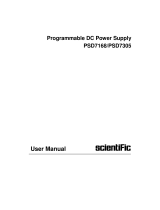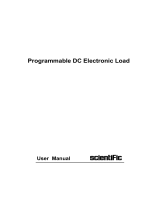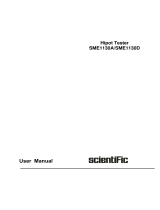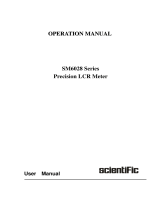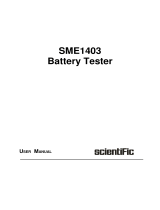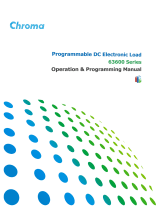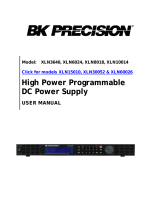
User Manual
Programmable DC Electronic Load
SME1900 Series

Scientific
SME1900_User Manual 2/129
Copyright © Scientific All rights reserved.
This instrument contains proprietary information, no part of this manual may be photocopied, reproduced or
translated without any prior written consent.
Information in this manual supersede all corresponding previous released material.
Scientific continues to improve products and reserves rights to amend part or all of the specifications,
procedures, equipment at any time without notice.
Rev 1.0/ 0523
Scientific Mes-Technik Pvt. Ltd.,
B-14 Industrial Estate, Pologround,
Indore- 452015 (India)
Tel : 0731-2422330/31/32/33
Fax : 0731-2422334,561641
Email : info@scientificindia.com
Website: www.scientificindia.com

Scientific
SME1900_User Manual 3/129
Catalog
Chapter 1 Introduction to the Instrument ........................................................................................ 7
1.1 Introduction .................................................................................................................... 7
1.2
Conditions of use ............................................................................................................ 8
1.2.1
Power connection .................................................................................................... 8
1.2.2
Environmental conditions ........................................................................................ 8
1.2.3
Cautions .................................................................................................................. 8
1.2.4 Warm-up ................................................................................................................. 9
1.3
Safety and Signs ............................................................................................................ 9
1.3.1
Symbols and Signs ................................................................................................. 9
1.3.2
Laws and Regulations ............................................................................................. 10
Chapter 2 Overview .............................................................................................................................. 11
2.1
Front Panel Description .................................................................................................. 11
2.2
Rear Panel Description .................................................................................................. 12
2.3 MF1900-2 Appearance ................................................................................................... 13
2.4
Display Area Definition ................................................................................................... 14
2.5
Basic operation ............................................................................................................... 15
2.5.1
Regular mode .......................................................................................................... 15
2.5.2
Advanced Mode ...................................................................................................... 15
2.6
Power-on instructions ..................................................................................................... 15
Chapter 3 Overview of Instrument Functions ...................................................................................... 16
3.1 Introduction .................................................................................................................... 16
3.2
Model Introduction .......................................................................................................... 16
3.2.1
CC Constant Current Mode .................................................................................... 16
3.2.2
CR Constant resistance mode ................................................................................ 17
3.2.3
CV Constant Voltage Mode .................................................................................... 17
3.2.4
CP Fixed Power Mode ............................................................................................ 18
3.2.5
DYN Dynamic Load Mode ...................................................................................... 18
3.2.6
SWP Dynamic Frequency Scan Mode ................................................................... 18
3.2.7
CR-LED Test Mode ................................................................................................. 19
3.2.8
BATT Battery Test Mode......................................................................................... 19
3.2.9
TIMING Time measurement mode ......................................................................... 20
3.2.10
MPPT Maximum Power Point Tracking Test Mode ................................................ 20
3.2.11
OCPT Overcurrent Protection Test Mode ............................................................... 20
3.2.12
OVPT Overvoltage Protection Test Mode .............................................................. 21
3.2.13
OPPT Overpower Protection Test Mode ................................................................ 21
3.2.14
SINE Sine wave test mode ..................................................................................... 22
3.2.15
LIST List Test Pattern ............................................................................................. 22

Scientific
SME1900_User Manual 4/129
3.2.16
AUTO automatic test mode ..................................................................................... 22
3.3
Protection function .......................................................................................................... 23
3.3.1
Overvoltage protection (OVP) ................................................................................. 23
3.3.2
Overcurrent Protection (OCP) ................................................................................. 23
3.3.3
Overpower Protection (OPP) .................................................................................. 23
3.3.4
Over Temperature Protection (OTP) ...................................................................... 24
3.3.5
Input polarity reversal protection (REV) .................................................................. 24
3.4
ALLRUN Function ........................................................................................................... 24
3.5
Module inline .................................................................................................................. 24
3.5.1
Module Online Settings ........................................................................................... 24
3.5.2
Caution .................................................................................................................... 25
3.6
CAN Online ..................................................................................................................... 25
Chapter 4 Basic Operations and Instructions ................................................................................ 26
4.1
Measurement display ..................................................................................................... 26
4.1.1
General mode description ....................................................................................... 26
4.1.2
Advanced mode description .................................................................................... 26
4.2
General mode setting ..................................................................................................... 27
4.2.1
CC mode setting ..................................................................................................... 27
4.2.2
CR mode setting ..................................................................................................... 29
4.2.3
CV mode setting ...................................................................................................... 30
4.2.4
CP mode setting ...................................................................................................... 32
4.3
Advanced Mode Settings ............................................................................................... 34
4.3.1
DYN Mode Settings ................................................................................................. 34
4.3.2
SWP mode setting .................................................................................................. 36
4.3.3
CR-LED mode setting ............................................................................................. 39
4.3.4
BATT mode setting ................................................................................................. 41
4.3.5
TIMING mode setting .............................................................................................. 43
4.3.6
MPPT mode setting ................................................................................................. 46
4.3.7
OCPT mode setting ................................................................................................. 47
4.3.8
OVPT mode setting ................................................................................................. 50
4.3.9
OPPT mode setting ................................................................................................. 51
4.3.10
SINE mode setting .................................................................................................. 54
4.3.11
LIST mode setting ................................................................................................... 55
4.3.12
AUTO mode setting ................................................................................................. 58
4.4 System Setup ................................................................................................................ 67
4.4.1
Description and operation ....................................................................................... 67
4.4.2
Setting parameter description and operation .......................................................... 67
4.5 Function Setting ............................................................................................................. 68
4.5.1
Description and operation ........................................................................................ 68

Scientific
SME1900_User Manual 5/129
4.5.2
Setting parameter description and operation .......................................................... 69
4.6 Limit setting ................................................................................................................... 72
4.6.1
Description and operation ....................................................................................... 72
4.6.2
Setting parameter description and operation .......................................................... 73
4.7 Online Settings .............................................................................................................. 76
4.7.1
Description and operation ....................................................................................... 76
4.7.2
Setting parameter description and operation .......................................................... 76
4.8
Digital setup .................................................................................................................... 77
4.8.1
Description and operation ....................................................................................... 77
4.8.2
Setting parameter description and operation .......................................................... 78
4.9
Machine information and upgrades ................................................................................ 79
4.9.1
Description and operation ....................................................................................... 79
4.9.2
Setting parameter description and operation .......................................................... 79
4.10 Base plate setting .......................................................................................................... 80
4.10.1
Description and operation ................................................................................ 80
4.10.2
Setting parameter description and operation .................................................. 80
4.11 Base plate communication ............................................................................................ 82
4.11.1
Description and operation ................................................................................ 82
4.11.2
Setting parameter description and operation .................................................. 82
Chapter 5 Document Management ................................................................................................ 83
5.1 Module file ..................................................................................................................... 83
5.1.1 Description ............................................................................................................. 83
5.1.2 Operation ................................................................................................................ 84
Chapter 6 Communication Interface .............................................................................................. 85
6.1 RS232 Interface .............................................................................................................. 85
6.1.1 Description ............................................................................................................. 85
6.1.2 Operation ................................................................................................................ 86
6.2
USBTMC Remote Control System ................................................................................. 87
6.2.1
System Configuration .............................................................................................. 87
6.2.2
Installing the driver .................................................................................................. 87
6.3
USBCDC6-3 ................................................................................................................... 88
6.3.1 Description ............................................................................................................. 88
6.3.2 Installing the driver ................................................................................................. 88
6.4
GPIB Interface ................................................................................................................ 88
6.4.1
CPIB Bus ................................................................................................................. 88
6.4.2
GPIB Interface Function .......................................................................................... 91
6.4.3
GPIB Address.......................................................................................................... 91
Chapter 7 Communication Command Reference ................................................................................ 92
7.1 SCPI Instructions ............................................................................................................ 92

Scientific
SME1900_User Manual 6/129
7.1.1 IEEE488.2 Common Commands ............................................................................ 93
7.1.2
ABORt Subsystem Command Set .......................................................................... 93
7.1.3
ADVance Subsystem Command Set ...................................................................... 93
7.1.4
CHANnel Subsystem Command Set .................................................................... 105
7.1.5
CONFigure Subsystem Command Set ................................................................. 106
7.1.6
CURRent Subsystem Command Set .................................................................... 110
7.1.7
DIGitizing Subsystem Command Set ................................................................... 114
7.1.8
FETCh subsystem command set .......................................................................... 116
7.1.9
LOAD subsystem command set ........................................................................... 118
7.1.10
MEASure Subsystem Command Set .................................................................... 119
7.1.11
MODE Subsystem Command Set ........................................................................ 120
7.1.12
POWer Subsystem Command Set ....................................................................... 120
7.1.13
RESistance Subsystem Command Set ................................................................ 121
7.1.14
RUN Subsystem Command Set ........................................................................... 122
7.1.15
SHOW Subsystem Command Set ........................................................................ 122
7.1.16
SPECification Subsystem Command Set ............................................................. 122
7.1.17
VOLTage Subsystem Command Set .................................................................... 125
7.2 Command Examples ................................................................................................... 126
Chapter 8 Dispatch Procedure, E-waste Management & Warranty ............................................ 129

Scientific
SME1900_User Manual 7/129
Chapter 1 Introduction to the instrument
Thank you for purchasing and using our products. Before you use this instrument, please first
see the last chapter of the manual "Service, E-Waste Management and Warranty”. Please
contact us if you need any help.
1.1
Introduction
SME1900 series programmable DC electronic load, the main functions and advantages are as
follows:
The maximum power of SME1900 system is 2000W and the maximum current is 400A.
The individual module’s maximum power is 400W, maximum current is 80A, maximum
voltage is 80V.
A single mainframe supports up to five modules in parallel and up to ten channels.
Connect via CAN interface and support up to four whole machines online.
500kHz ADC sampling rate.
Dynamic pull mode up to 50 kHz.
24-bit color 2.8-inch color LCD display.
Smart Fan System.
Support power-on hold function.
Support timer function.
Support RS232, USB, LAN, GPIB interfaces for easy data communication with PC.
Support signal output function (SYSTEM I/O).
Electrically isolated, external inputs and outputs.
Supports over-current protection (OCP), over-voltage protection (OVP), over-power protection
(OPP), over-temperature protection (OTP), reverse polarity protection (REV), and low-voltage
protection (LVP).
The SME1900 series programmable DC electronic loads include the following types of modules
Mainframe Model Maximum number of modules supported
MF1900-5 5
MF1900-2 2
Table 1-1 Frame Model
Module Number Voltage Current Power I/P Channels
SME1901 80V 20A 100W 2
SME1902 80V 40A 200W 1
SME1903 80V 60A 300W 1
SME1904 80V 80A 400W 1
Table 1-2 Main specifications of each model module

Scientific
SME1900_User Manual 8/129
1.2
Conditions of use
1.2.1
Power connection
1) Supply voltage range: MF1900-5: 175~253VAC.
MF1900-2: 100VAC or 220VAC, switchable via rear panel switch.
2) Power supply frequency range: 47~63Hz.
3) Power supply range: 300VA max.
4) The power input phase L, zero N and ground E should be the same as the power
plug of this instrument.
1.2.2
Environmental
conditions
The SME1900 series programmable DC electronic load is only allowed to be used indoors
and in low condensation areas, and the general environmental requirements of this
instrument are shown in Table 1-3. The fan speed of SME1900 series programmable DC
electronic load changes intelligently with the pulling power, and the instrument stops the
pulling current when the temperature reaches the over-temperature protection trigger value.
Table 1-3 Instrument environmental requirements
1.2.3
Caution
1) Please do not use it in adverse environment such as dusty, vibration, direct sunlight,
corrosive gas, explosive gas, steam, etc.
2) Do not use the equipment that has been damaged. Before using the equipment, check
its housing for cracks.
3) Please use the cable provided to connect the equipment. Before operating the
instrument, you should make sure that the AC power supply is well grounded.
4) Before connecting the device, check all security markings on the device.
5) Use wires with proper load ratings. All load wires must have the capacity to carry the
maximum short-circuit output current of the power supply without overheating. If there
are multiple loads, each pair of load wires must be able to safely carry the full rated
short-circuit output current of the power supply.
6) Do not install replacement parts on the instrument yourself or perform any
unauthorized modifications.
Environmental conditions Requirements
Operating temperature 0 ~40
Operating humidity 10%~90% (non-condensing)
Storage temperature -20°C~70°C
Altitude Operating at altitudes up to 2000 m
Pollution degree Pollution degree 2
Security Level Safety Category II

Scientific
SME1900_User Manual 9/129
7) Do not use this equipment with the cover removed or loose.
8) The use of this instrument on life support systems or any other equipment with safety
requirements is strictly prohibited.
9) Please keep a good ventilation around the four sides of this instrument to avoid
overheating of the instrument. Do not block the ventilation holes of the equipment to
avoid the internal temperature rising and affecting the accuracy.
10) Please use a dry cloth to clean the device housing, do not clean the inside of the
instrument.
11) Do not switch the instrument on and off frequently to avoid loss of stored data.
12) This instrument has been carefully designed to reduce noise interference due to the
input from the AC power supply terminal, however, it should still be used in a low noise
environment as much as possible. If this cannot be avoided, please install a power
supply filter.
13) If the instrument is not used for a long time, please put it in the original packing box or
similar case. Store in a ventilated room at a temperature of 5°C to 40°C and a relative
humidity of not more than 85% RH. The air should not contain harmful impurities that
corrode the meter and should be protected from direct sunlight.
1.2.4
Warm-up
To ensure accurate measurement, the warm-up time should be at least 30 minutes.
1.3
Safety and Signs
1.3.1
Symbols and Signs
ON (power closed)
Protective earth
terminal
OFF (power off)
Grounding
terminal
Warning Sign
Ground
connection end
identification
Electric shock
hazard sign
Table 1-4 Basic conformity and sign

Scientific
SME1900_User Manual 10/129
1.3.2
Laws and Regulations
The CE mark indicates that the product complies with all relevant European
legislation (if it carries the year, it indicates the year in which this design was
approved).
This apparatus complies with the labelling requirements of the WEEE
Directive (2002/96/EC) and this additional product label indicates that this
appliance/electronic product must not be disposed of in household waste.
According to the classification of equipment in Annex I of the WEEE Directive,
this apparatus belongs to the "monitoring category".

Scientific
SME1900_User Manual 11/129
Chapter 2 Overview
The content of this chapter is only a general description. It mainly introduces the front and rear
panels, display area, power-on interface, and basic operation, etc. Refer to Chapter 4 for specific
operations and detailed explanations.
2.1
Front Panel Description
The front panel of SME1900 series programmable DC electronic load is shown in Figure
2-1.
Figure 2-1 Front Panel
Marking
Name Function
1 Power Switch Instrument power on
2 Trademark and model Introduction of instrument models
3 USB flash drive interface Upgrade firmware version
4 Current terminal Power connection via current terminal
5 Vsense Terminals Remote voltage measurement terminal
6 Module Model Introduction of module models
7 LCD Display Display settings and output
8 Menu key Response menu function
9 Module function key Switch each function module and pull the
load current
10 Knob Adjust the set value or move the cursor
Table 2-1 Front Panel Description

Scientific
SME1900_User Manual 12/129
2.2
Rear Panel Description
The rear panel of SME1900 series programmable DC electronic load is shown in Figure 2-2.
Figure 2-2 Rear Panel
Marking Name Function
1 RS232 serial
interface
RS232 serial communication interface for on-line communication with
PC.
2 LAN port LAN port communication for online communication with computers.
3 System Bus
Interface
CAN interface for on-line connection between whole machines.
4 USB Interface USB Device interface for online communication with PC.
5 System I/O
Interface
Signal input and output
6 GPIB Interface GPIB interface for on-line communication with PC.
7 Fuse Protecting the machine
8 Power outlets Connecting power
9 Fans Heat Dissipation
Table 2-2 Rear Panel Description

Scientific
SME1900_User Manual 13/129
2.3
MF1900-2 Appearance
Figure 2-3 MF1900-2 Front Panel
Figure 2-4 MF1900-2 Rear Panel

Scientific
SME1900_User Manual 14/129
2.4
Display area definition
The SME1900 series programmable DC electronic load adopts a 24-bit color 2.8-inch color
LCD screen with a resolution of 320×240. The display is divided into the following display
areas, as shown in Figure 2-5.
Figure 2-5 Description of the display area
1) Title area
This area indicates the current mode.
2) Measurement results display area
This area displays the results of the tested parameters.
3) Shortcut setting area
This area is used for quick settings in general mode.
4) Menu display area
This area displays the function menu, quick setup mode.
2.5
Basic operation
2.5.1
General mode
1)
Set the general mode: Press Mode to select the mode.
2)
Pull load current: Press Load.
2.5.2
Advanced Mode
1)
Set advanced mode: Press ADVA to select the mode.
2)
Pull load current: Press Load.

Scientific
SME1900_User Manual 15/129
2.6
Power on instructions
Press the power switch at the lower left corner of the front panel of the instrument, the
instrument turns on and displays the power-on screen. Figure 2-6 shows the power-on
screen of SME1900 series programmable DC electronic load. The power-on screen includes
some product information such as trademark, instrument model and version number of
Scientific company. The instrument will self-test when it is turned on and will stay in the
power-on screen if there is any abnormality.
Figure 2-6 Power-on screen

Scientific
SME1900_User Manual 16/129
Chapter 3 Overview of Instrument Functions
3.1
Introduction
The SME1900 series programmable DC electronic loads contain slots for five modules and
can reach a maximum power of 2000W and supports up to ten channels.
Each module has an independent intelligent fan, and the fan speed varies with power. When
the module temperature exceeds the over-temperature protection value, the module stops
pulling the load current.
The general mode contains CC, CR, CV, and CP.
The advanced modes include DYN, SWP, CR-LED, BATT, TIME, MPPT, OCPT, OVPT,
OPPT, SIN, LIST, AUTO.
CC --- Constant current mode
CR --- Constant resistance mode
CV --- Constant voltage mode
CP --- Constant power mode
DYN --- Dynamic load mode
SWP --- Dynamic Frequency Scan Mode
CR-LED --- Analog LED Test Mode
BATT --- Battery Test Mode
TIME --- Timing test mode
MPPT --- Maximum Power Point Tracking Test Mode
OCPT --- Over Current Protection Test Mode
OVPT --- Over Voltage Protection Test Mode
OPPT --- Over Power Protection Test Mode
SINE --- Sine Wave Test Mode
LIST --- List test mode
AUTO --- Auto test mode
3.2
Model Introduction
3.2.1 CC Constant Current Mode
In constant current mode, the electronic load always consumes a constant current regardless
of whether the input voltage changes or not. As shown in Figure 3-1. The starting pull current
is 0.1% of full scale.

Scientific
SME1900_User Manual 17/129
Figure 3-1 CC Mode
3.2.2 CR Constant resistance mode
In constant resistance mode, the electronic load is equivalent to a constant resistance, and
the electronic load will change the current linearly with the change of voltage. As shown in
Figure 3-2.
Figure 3-2 CR mode
3.2.3 CV Constant Voltage Mode
In constant voltage mode, the electronic load controls the power supply output voltage by
adjusting the pull load current according to the set voltage value. As shown in Figure 3-3.
Figure 3-3 CV Mode

Scientific
SME1900_User Manual 18/129
3.2.4 CP Fixed Power Mode
In the constant power mode, the electronic load always consumes a constant power.
According to the formula: P = V × I, if the input voltage V increases, the current I will be forced
to decrease to keep the power constant. This is shown in Figure 3-4.
Figure 3-4 CP Mode
3.2.5 DYN Dynamic Load Mode
Dynamic load mode allows the load to switch between two current levels repeatedly.
Dynamic load mode requires setting two current levels, the duration of each current level,
the ramp up, the ramp down, and the number of repetitions. The number of repetitions
determines the number of cycles of the entire high and low current pull load, ranging from 0
to 65535, with 0 indicating infinite cycles. As shown in Figure 3-5.
Figure 3-5 DYN Mode
3.2.6 SWP Dynamic Frequency Scan Mode
The electronic load provides a unique dynamic frequency sweep to find the worst-case
voltage to be measured with frequency conversion. The dynamic frequency sweep requires
setting two current levels, start frequency, end frequency, step frequency, duration, rise slope,
and fall slope. When operated, the electronic load will pull the current at the set frequency for
the set duration.

Scientific
SME1900_User Manual 19/129
Figure 3-6 SWP mode
3.2.7 CR-LED test mode
Under the traditional CR mode, the electronic load increases the setting of diode conduction
voltage, so that the electronic load will work only when the voltage added to both ends of the
electronic load is greater than the conduction voltage of the diode, which completely and truly
simulates the working principle of the diode, so the electronic load can simulate the ripple
current during the real LED test.
3.2.8 BATT Battery Test Mode
The electronic load can perform battery discharge test based on CC, CR or CP mode and
the termination conditions include voltage, timing, capacity, and energy. When the trigger
condition of trigger termination is reached, the battery stops discharging and the load stops
pulling the load current.

Scientific
SME1900_User Manual 20/129
3.2.9 TIMING Time measurement mode
The electronic load has a unique time measurement function, which can perform accurate
time measurement in the range of 0s to 100000s. The user can set CC, CR or CP mode to
start timing when the voltage reaches the starting voltage and stop timing when the voltage
reaches the end voltage, which can measure the time that the object under test is pulling load
in the target voltage interval. This feature allows for application in battery discharge testing
and other similar applications.
3.2.10 MPPT Maximum Power Point Tracking test mode
The electronic load provides a maximum power point tracking function with DSP-based
algorithms that can find out the maximum power provided by the power supply and at the
same time can provide the voltage and current corresponding to the maximum power.
Figure 3-7 MPPT mode
3.2.11 OCPT Overcurrent Protection Test Mode
The electronic load has an over-current protection test (OCPT) function. In the OCPT test
mode, the electronic load pulls a step-up current to test whether the output voltage of the
power supply is lower than the trigger voltage in the overload condition, and then judge
whether the output protection function of the power supply is normal.
Page is loading ...
Page is loading ...
Page is loading ...
Page is loading ...
Page is loading ...
Page is loading ...
Page is loading ...
Page is loading ...
Page is loading ...
Page is loading ...
Page is loading ...
Page is loading ...
Page is loading ...
Page is loading ...
Page is loading ...
Page is loading ...
Page is loading ...
Page is loading ...
Page is loading ...
Page is loading ...
Page is loading ...
Page is loading ...
Page is loading ...
Page is loading ...
Page is loading ...
Page is loading ...
Page is loading ...
Page is loading ...
Page is loading ...
Page is loading ...
Page is loading ...
Page is loading ...
Page is loading ...
Page is loading ...
Page is loading ...
Page is loading ...
Page is loading ...
Page is loading ...
Page is loading ...
Page is loading ...
Page is loading ...
Page is loading ...
Page is loading ...
Page is loading ...
Page is loading ...
Page is loading ...
Page is loading ...
Page is loading ...
Page is loading ...
Page is loading ...
Page is loading ...
Page is loading ...
Page is loading ...
Page is loading ...
Page is loading ...
Page is loading ...
Page is loading ...
Page is loading ...
Page is loading ...
Page is loading ...
Page is loading ...
Page is loading ...
Page is loading ...
Page is loading ...
Page is loading ...
Page is loading ...
Page is loading ...
Page is loading ...
Page is loading ...
Page is loading ...
Page is loading ...
Page is loading ...
Page is loading ...
Page is loading ...
Page is loading ...
Page is loading ...
Page is loading ...
Page is loading ...
Page is loading ...
Page is loading ...
Page is loading ...
Page is loading ...
Page is loading ...
Page is loading ...
Page is loading ...
Page is loading ...
Page is loading ...
Page is loading ...
Page is loading ...
Page is loading ...
Page is loading ...
Page is loading ...
Page is loading ...
Page is loading ...
Page is loading ...
Page is loading ...
Page is loading ...
Page is loading ...
Page is loading ...
Page is loading ...
Page is loading ...
Page is loading ...
Page is loading ...
Page is loading ...
Page is loading ...
Page is loading ...
Page is loading ...
Page is loading ...
Page is loading ...
/
